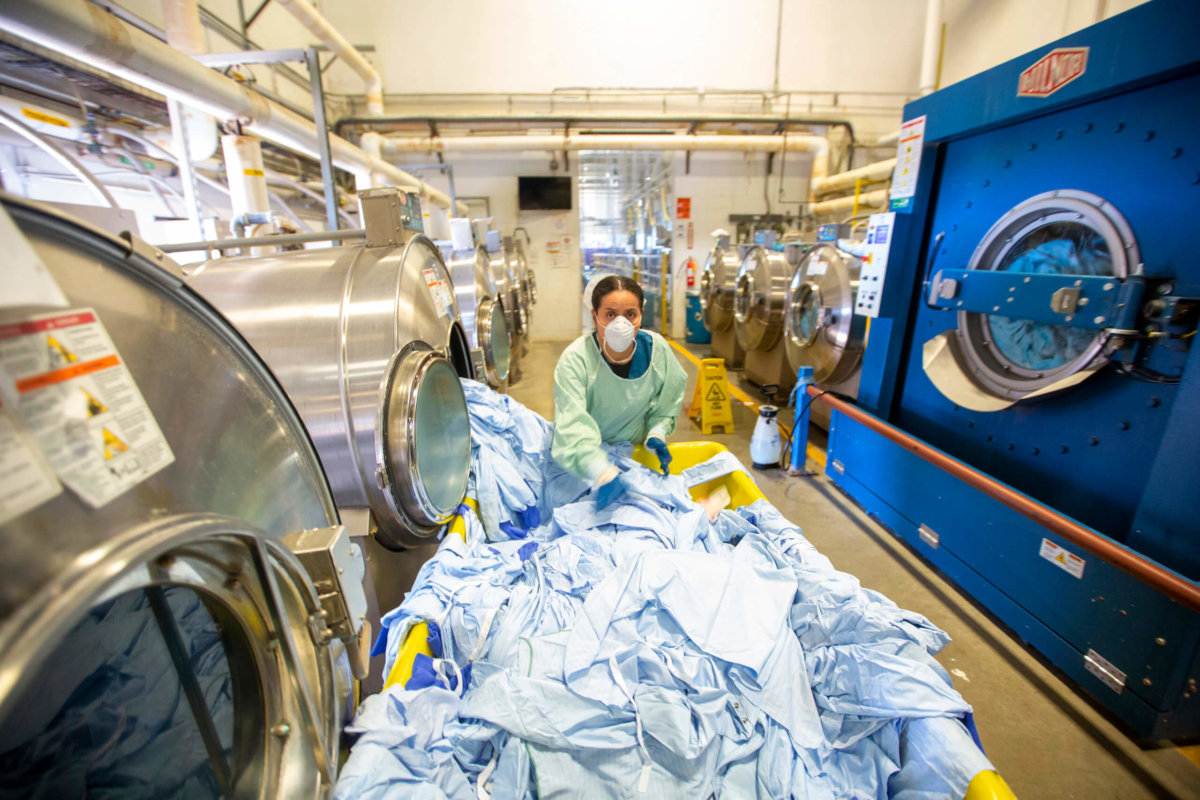Employer Responsibilities
A. Employers must launder workers’ personal protective garments or uniforms that are contaminated with blood or other potentially infectious materials.
Laundry Facilities and Equipment
A. . Maintain the receiving area for contaminated textiles at negative pressure compared with the clean areas of the laundry in accordance with AIA construction standards in effect during the time of facility construction.
B. Ensure that laundry areas have handwashing facilities and products and appropriate PPE available for workers.
C. Use and maintain laundry equipment according to manufacturers’ instructions.
D. Do not leave damp textiles or fabrics in machines overnight.
E. Disinfection of washing and drying machines in residential care is not needed as long as gross soil is removed before washing and proper washing and drying procedures are used.
Routine Handling of Contaminated Laundry
A. Handle contaminated textiles and fabrics with minimum agitation to avoid contamination of air, surfaces, and persons.
B. Bag or otherwise contain contaminated textiles and fabrics at the point of use.
1. Do not sort or prerinse contaminated textiles or fabrics in patient-care areas.
2. Use leak-resistant containment for textiles and fabrics contaminated with blood or body substances.
3. Identify bags or containers for contaminated textiles with labels, color coding, or other alternative means of communication as appropriate.
C. Covers are not needed on contaminated textile hampers in patient-care areas
D. If laundry chutes are used, ensure that they are properly designed, maintained, and used in a manner to minimize dispersion of aerosols from contaminated laundry.
1. Ensure that laundry bags are closed before tossing the filled bag into the chute.
2. Do not place loose items in the chute.
E. Establish a facility policy to determine when textiles or fabrics should be sorted in the laundry facility (i.e., before or after washing).
Laundry Process
A. If hot-water laundry cycles are used, wash with detergent in water ≥160°F (≥71°C) for ≥25 minutes.
B. No recommendation is offered regarding a hot-water temperature setting and cycle duration for items laundered in residence-style health-care facilities. Unresolved issue
C. Follow fabric-care instructions and special laundering requirements for items used in the facility.
D. Choose chemicals suitable for low-temperature washing at proper use concentration if low-temperature (<160°F [<71°C]) laundry cycles are used.
E. Package, transport, and store clean textiles and fabrics by methods that will ensure their cleanliness and protect them from dust and soil during interfacility loading, transport, and unloading.
Microbiologic Sampling of Textiles
A. Do not conduct routine microbiological sampling of clean textiles.
B. Use microbiological sampling during outbreak investigations if epidemiologic evidence suggests a role for health-care textiles and clothing in disease transmission.
Special Laundry Situations
A. Use sterilized textiles, surgical drapes, and gowns for situations requiring sterility in patient care.
B. Use hygienically clean textiles (i.e., laundered, but not sterilized) in neonatal intensive care units.
C. Follow manufacturers’ recommendations for cleaning fabric products including those with coated or laminated surfaces.
D. Do not use dry cleaning for routine laundering in health-care facilities.
E. Use caution when considering the use of antimicrobial mattresses, textiles, and clothing as replacements for standard bedding and other fabric items; EPA has not approved public health claims asserting protection against human pathogens for treated articles.
F. No recommendation is offered regarding using disposable fabrics and textiles versus durable goods.
Friday, February 24, 2023
Refrences
Centers for Disease Control and Prevention (CDC)- Guidelines for Environmental Infection Control i
Please Check out file at the following link
General Cleaning Strategies for Patient-Care Areas – Cleaning Housekeeping Surfaces
General Cleaning Strategies for Patient-Care Areas – Cleaning of Medical Equipment
Environmental Services – Principles of Cleaning and Disinfecting Environmental Surfaces
Strategies for Controlling Waterborne Microbial Contamination


